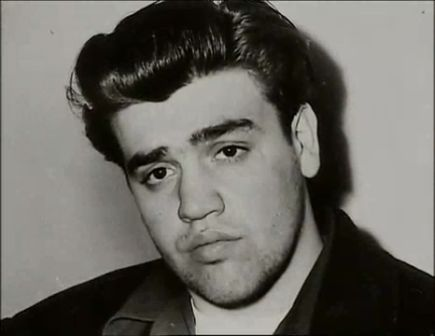Vincent Louis Chin Gigante, also known as “The Oddfather” for his largely successful efforts to dodge criminal punishment by faking mental illness, was a one-time boxer who rose from low-level enforcer to become don of one of the infamous “five families” of organized crime in New York City.
Unlike most of his predecessors in the mob, Gigante was born in America. He grew up in a family predisposed to gangsterism, with all but one of his four brothers becoming mobsters in the Genovese crime family; the fourth joined the priesthood.
Vincenzo Gigante was the son of jewel engraver Salvatore Esposito Vulgo Gigante and seamstress Yolanda Santasilia-Gigante, immigrants from Naples who never learned English. Vincent was born in 1928 on the Lower East Side of Manhattan, a predominantly immigrant community with a heavy Italian-American presence, especially in the Little Italy neighborhood.
Yolanda’s pronunciation of Vincent’s Italian given name, with a stress on the middle syllable (vin-CHEN-zo) gave rise to his nickname. Three of his brothers followed him into the Mafia, including Mario, who is retired as top capo and acting boss. A fourth, Louis, is a retired priest and former member of the New York City Council.

Vincent Chin Gigante got his start not as a gangster but as a pugilist. At 16 he dropped out of a vocational high school for textile workers to work in blue-collar jobs and fight as a professional boxer. About the same time, he started running with members of the Luciano crime family, known today as the Genovese family.
Over a boxing career that spanned just three years, Gigante fought 121 rounds in 25 matches, losing only four. He boxed as a light heavyweight, and he lost his first fight, against Vic Chambers in 1944, and his last, against Jimmy Slade in 1947. He fought several times at Madison Square Garden, winning most.
He spent much of this time associating with Philip “Benny Squint” Lombardo, member of the 116th Street Crew in East Harlem, and other powerful gangsters who belonged to the Luciano family. In 1945, Vito “Don Vito” Genovese, who had once been acting head of the family, returned from exile in Italy, and Gigante soon became associated with him.
It was mostly during the late 1940s and early 1950s that Gigante made his name as an earner and enforcer for the family. He was arrested seven times between ages 17 and 25 for various crimes associated with his mob mentors, including firearms beefs, illegal gambling and receiving stolen goods. Most were dismissed, and he never received a sentence longer than 60 days.
But Gigante’s big break came in 1957, when Genovese decided to make a move against the current don, Frank Costello. Charles “Lucky” Luciano had placed Genovese at the head of the family when Luciano went to prison in 1936, but Genovese was forced to abdicate when he fled to Italy to avoid prosecution on a murder charge. In his absence, Costello had taken over. Now that he was back, Genovese wanted Costello gone so he could resume control. Gigante got the job.
On May 2, 1957, Frank Costello was walking to the elevator in his apartment building at the corner of Central Park West and 72nd Street in Manhattan when Gigante stepped out and fired a .38-caliber handgun. The bullet hit Costello in the head.
But Costello moved just as the gun fired, and he was only grazed. Gigante, mistakenly thinking he had killed his target, fled, jumped into a black Cadillac and drove away. Ever a good Mafioso, Costello refused to identify his assailant. A doorman fingered him, but the defense team was able to attack his credibility and get Gigante off.
Unusually for a failed hit, there were few negative consequences for Chin Gigante, aside from the criminal trial. No one tried to rub him out for the failed job, and instead, he continued to rise through the ranks.
Gigante did, however, serve five years in prison in the early 1960s for heroin trafficking, where he shared a cell with Genovese. This strengthened his position within the family even further. Upon his release (he was paroled early after residents of his Greenwich Village neighborhood pleaded with the judge), he was put in charge of the Greenwich Crew by Genovese, rising to caporegime.
Chin Gigante had his hands in several pies. He dealt in loansharking and enforcement, bookmaking, hijacking, extortion, and labor racketeering in the hauling and construction industries. His crew, one of the most powerful in New York, ran organized crime rackets throughout Lower Manhattan. Under his command, they dominated the scene for more than a decade, starting in the late 1960s.
The reach of the Greenwich Crew wasn’t strictly limited to Downtown. Mario Gigante, Vincent’s older brother, spread the group’s influence to the Bronx, Yonkers and Westchester County. Vincent Gigante employed other members of his family, including sons Andrew and Vincent Esposito.
Chin Gigante’s work for the Greenwich Crew under Genovese also marked the beginning of a legal and psychological game that would last more than three decades. He was indicted in New Jersey in 1969 on charges he tried to bribe members of the Old Tappan Police Department to tip him off to surveillance by other police outfits. He got the charges dropped using psychiatric reports that he was mentally unfit to stand trial. He would spend much of the rest of his life elaborately feigning mental illness in order to avoid criminal convictions.
